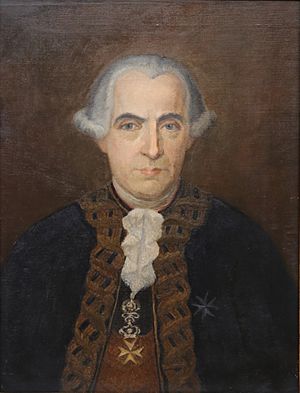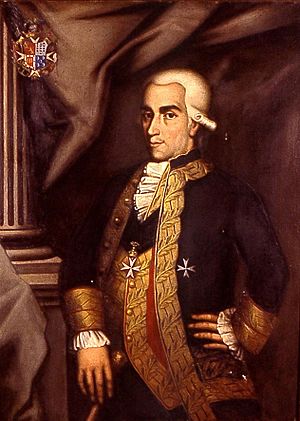Francisco Gil de Taboada facts for kids
Francisco Gil de Taboada y Lemos (born September 24, 1733, in Galicia, Spain – died 1809 in Madrid) was an important Spanish naval officer. He also served as a colonial administrator in South America. He was briefly the viceroy of New Granada in 1789. Then, from 1790 to 1796, he was the viceroy of Peru. After his time as viceroy, he went back to Spain. There, he became part of the ruling council after King Ferdinand VII had to give up his throne because of Napoleon. He also held a high position as the director general of the Spanish Royal Navy.
Contents
Francisco Gil de Taboada y Lemos was born in 1733 in Galicia, Spain. When he was 16, he became a knight of the Order of St. John of Jerusalem, which was a special group.
He joined the navy as a cadet in Cádiz in 1752. A cadet is like a student training to be an officer. He slowly moved up the ranks. In 1767, he became a lieutenant. During these years, he sailed across the Mediterranean Sea, the Atlantic Ocean, and the Pacific Ocean.
He was promoted to commander in 1770 and to captain in 1776. From 1774 to 1777, he was the Spanish governor of the Malvinas Islands. In 1779, he became the captain of a new training school for naval cadets in Ferrol. He stayed in this role until he was chosen to be a viceroy. By this time, he was a squadron commander, which is a high rank in the navy.
Serving as Viceroy of New Granada
In January 1789, Francisco Gil de Taboada started his new job as viceroy and captain general of New Granada. He was also the president of the Audiencia (a high court and administrative body) in Santa Fe de Bogotá. However, he only stayed in this position until July of that year. He was then appointed as the viceroy of Peru. In March 1789, he was promoted to lieutenant general in the navy.
Leading as Viceroy of Peru
In Peru, Francisco Gil de Taboada made many important changes. He improved how the government was run and encouraged literature and the arts. He also sent out groups to explore new areas.
Besides being a naval officer who had fought in many places, Gil de Taboada was also very interested in learning and culture. In Peru, he was known for supporting arts, science, and exploration. He helped start a newspaper called El Mercurio Peruano in 1791. He also founded the Academy of Fine Arts, which taught painting and sculpture.
He opened a center for studying anatomy and a hospital. He also supported a school for navigation, which taught people how to sail ships. He ordered the first official count of the population in Peru. In 1796, he brought the region of Puno back under the control of the Viceroyalty of Peru.
When his time as viceroy ended in 1796, he returned to Spain. There, his actions as viceroy were reviewed in a special process called a juicio de residencia. This was a common review to check the finances and administration of a viceroy. The review found that he had done a good job.
Return to Spain and High Positions
In 1799, Francisco Gil de Taboada was named the director general of the Spanish navy. He held this important position, along with others, until 1807.
In 1805, he became the temporary secretary of state for the navy. Later that year, he was promoted to captain general in the navy, which is a very high rank. In 1806, he was officially named the minister of the navy.
These high roles were under King Charles IV. However, in 1808, a rebellion called the Mutiny of Aranjuez forced King Charles to give up his throne. His son, Ferdinand VII, became the new king. These events changed Spanish politics a lot and had a huge impact on the Spanish colonies in America.
Serving in the Governing Junta
The new King Ferdinand VII kept his father's ministers, including Gil de Taboada, in their jobs.
However, Napoleon invited both King Charles and King Ferdinand to France. They left Spain in April 1808. In France, Napoleon forced them to give up the Spanish crown. He then gave it to his brother, Joseph I of Naples. This started a long period of exile for the Spanish kings.
Before leaving for France, King Ferdinand VII had created a ruling council called the Junta Suprema de Gobierno. This council was made up of his ministers, and his uncle, Infante Antonio, led it. Gil de Taboada was still the minister of the navy. When a French general named Joachim Murat demanded that a former prime minister be handed over to the French, Gil strongly disagreed.
Fearing the French influence, Gil suggested moving the council away from Madrid. After a popular uprising in Madrid on May 2, 1808 (known as the Second of May), Infante Antonio was forced to join the kings in France. Antonio wrote to Gil, saying the council should continue. But Murat demanded to lead it. Most members agreed, but Gil did not. He resigned a few days later.
After the Battle of Bailén in July 1808, where the French army was defeated, Gil de Taboada was asked to join another governing council. This was called the Junta Suprema Central. This happened in September 1808. When the French took over the capital again, they demanded that everyone promise loyalty to Joseph Bonaparte, the new King Joseph I of Spain. Gil, who was very old by then, refused to do so.
Francisco Gil de Taboada died the next year. The French soldiers in Madrid gave him a respectful funeral, showing how important he was.
See also
 In Spanish: Francisco Gil de Taboada para niños
In Spanish: Francisco Gil de Taboada para niños



